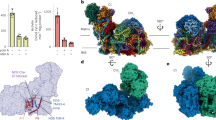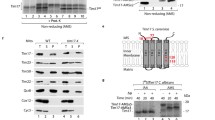Abstract
The mitochondrial citrate synthases (EC 4.1.3.7) of pummelo, potato and Arabidopsis are activated in crude extracts by dithiothreitol treatment and/or inactivated by the strong oxidizing agent diamide. Surprisingly, homology modeling reveals a potential disulfide involving two cysteine residues which are also present in the redox-insensitive model enzyme, pig heart citrate synthase. Energy minimization calculations suggest that differences in the charge distribution enhance disulfide bond formation in the plant mitochondrial citrate synthase and inhibit disulfide bond formation in the mammalian enzyme.
Similar content being viewed by others
References
Abola EE, Bernstein FC, Bryant SH, Koetzle TF and Weng J (1987) Protein data bank. In: Allen FH, Bergerhoff G and Sievers R (eds) Crystallographic Databases-Information Content, Software System, Scientific Application, pp 107-132. Data Commission of the Int'l Union of Crystallography, Bonn, Cambridge, Chester
Anderson LE (1986) Light/dark modulation of enzyme activity in plants. In: Callow JA (ed) Advances in Botanical Research, Vol 12, pp 1-46. Academic Press, New York
Anderson LE, Li D, Prakash N and Stevens FJ (1995) Identification of potential redox-sensitive cysteines in cytosolic forms of fructosebisphosphatase and glyceraldehyde-3-phosphate dehydrogenase. Planta 196 118-124
Anderson LE, Huppe HC, Li AD and Stevens FJ (1996) Identification of a potential redox-sensitive inter-domain disulfide in the sedoheptulose bisphosphatase of Chlamydomonas reinhardtii. Plant J 10: 553-560
Anderson LE, Li AD, Nehrlich SC, Hill MH and Stevens FJ (1997) The cytosolic fructose bisphosphatase of Brassica napuscontains a new potential regulatory disulfide and is redox-sensitive. Plant Sci 128: 23-30
Bernstein FC, Koetzle TF, Williams GJB, Meyer EF, Jr, Brice MD, Rodgers JR, Kennard O, Shimanouchi T and Tasumi M (1977) The protein data bank: A computer-based archival file for macromolecular structures. J Mol Biol 112: 535-542
Bodenstein-Lang J, Buch A and H Follmann H (1989) Animal and plant mitochondria contain specific thioredoxins. FEBS Lett 258: 22-26
Bradford MM (1976) A rapid and sensitive method for the quantitation of microgram quantities of proteins utilizing the principle of protein-dye binding. Anal Biochem 72: 248-254
Buchanan BB (1991) Regulation of CO2assimilation in oxygenic photosynthesis. Arch Biochem Biophys 288: 1-9
Canel C, Bailey-Serres JN and Roose ML (1996) Molecular characterization of the mitochondrial citrate synthase gene of an acidless pummelo (Citrus maxima). Plant Mol Biol 31: 143-147
Careaga CL and Falke JJ (1992) Structure and dynamics of Escherichia colichemosensory receptors. Engineered sulfhydryl studies. Biophys J 62: 209-219
Careaga CL, Sutherland J, Sabeti J and Falke JJ (1995) Large amplitude twisting motions of an interdomain hinge: A disulfide trapping study of the galactose-glucose binding protein. Biochemistry 34: 3048-3055
Follmann H, Banze M and Schwebke C (1997) Mitochondrial thioredoxin in plants: In search of structures and mechanisms. Fed Proc 11: A1020 (Abstract 951)
Gilbert HF (1990) Molecular and cellular aspects of thiol-disulfide exchange. Adv Enzymol 63: 69-172
Kato A, Hayashi M, Mori H and Nishimura M (1995) Molecular characterization of a glyoxysomal citrate synthase that is synthesized as a precursor of higher molecular mass in pumpkin. Plant Mol Biol 27: 377-390
Köller W and Kindl H (1977) Glyoxylate cycle enzymes of the glyoxysomal membrane from cucumber cotyledons. Arch Biochem Biophys 181: 236-248
Kraulis PJ (1991) MOLSCRIPT: A program to produce both detailed and schematic plots of protein structures. J Appl Crystallog 24: 946-950
La Cognata U, Landschütze V, Willmitzer L and Müller-Röber B (1996) Structure and expression of mitochondrial citrate synthases from higher plants. Plant Cell Physiol 37: 1022-1029
Landschütze V, Müller-Röber B and Willmitzer L (1995) Mitochondrial citrate synthase from potato: Predominant expression in mature leaves and young flower buds. Planta 196: 756-764
Li D, Stevens FJ, Schiffer M and Anderson LE (1994) Mechanism of light modulation: Identification of potential redox-sensitive cysteines distal to catalytic site in light-activated chloroplast enzymes. Biophys J 67: 29-35
Muslin EH, Li D, Stevens FJ, Donnelly M, Schiffer M and Anderson LE (1995) Engineering a domain-locking disulfide into a bacterial malate dehydrogenase produces a redox-sensitive enzyme. Biophys J 68: 2218-2223
Nicholls A, Sharp KA and Honig B (1991) Protein folding and association: Insights from the interfacial and thermodynamic properties of hydrocarbons. Proteins 11: 281-296
Remington S, Wiegand G and Huber F (1982) Crystallographic refinement and atomic models of two different forms of citrate synthase at 2.7 and 1.7 Å resolution. J Mol Biol 158: 111-152
Scheibe R (1991) Redox-modulation of chloroplast enzymes — a common principle for individual control. Plant Physiol 96: 1-3
Srere PA and Kosicki GW (1961) The purification of citrate-condensing enzyme. J Biol Chem 236: 2557-2559
Sulston J and Hodgkin J (1988) Methods. In: Wood WB (ed) The Nematode Caenorhabditis elegans, pp 587-606. Cold Spring Harbor Laboratory Press, Cold Spring Harbor, NY
Thornton JM (1981) Disulphide bridges in globular proteins. J Mol Biol 151: 261-287
Unger EA, Hand JM, Cashmore AR and Vasconcelos AC (1989) Isolation of a cDNA encoding mitochondrial citrate synthase from Arabidopsis thaliana. Plant Mol Biol 13: 411-418
Vanlerberghe GC, Day DA, Wiskich JT, Vanlerberghe AE and McIntosh L (1995) Alternative oxidase activity in tobacco leaf mitochondria. Dependence on tricarboxylic acid cycle-mediated redox regulation and pyruvate activation. Plant Physiol 109: 353-361
Zehler H, Thomson K-S and Schnarrenberger C (1984) Citrate synthases from germinating castor bean seeds — 1. Purification and properties. Physiol Plant 60: 1-8
Author information
Authors and Affiliations
Rights and permissions
About this article
Cite this article
Stevens, F.J., Dong Li, A., Salman Lateef, S. et al. Identification of potential inter-domain disulfides in three higher plant mitochondrial citrate synthases: Paradoxical differences in redox-sensitivity as compared with the animal enzyme. Photosynthesis Research 54, 185–197 (1997). https://doi.org/10.1023/A:1005991423503
Issue Date:
DOI: https://doi.org/10.1023/A:1005991423503




